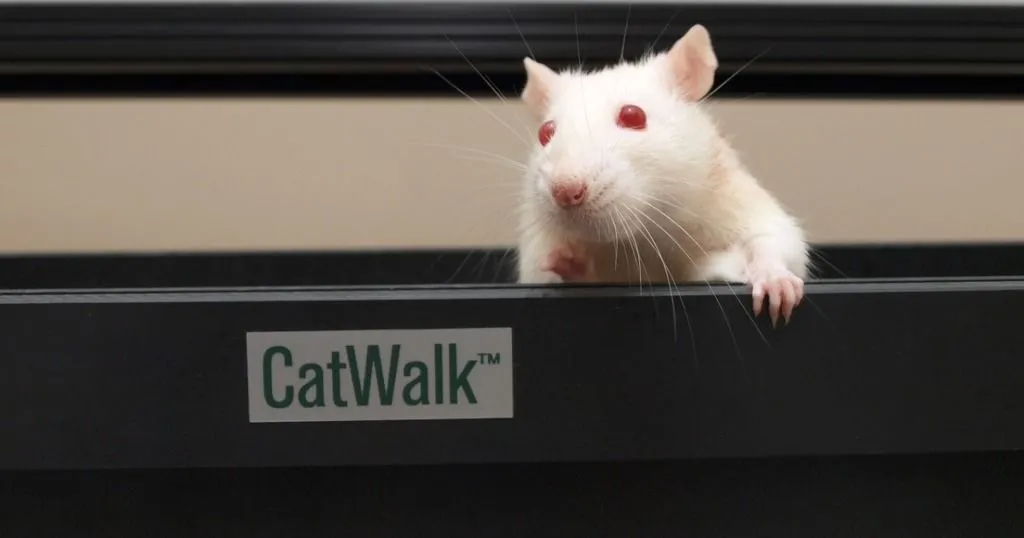10 behavioral studies on Alzheimer’s and Parkinson’s
This blog post features 10 interesting studies that use innovative techniques to study models of AD and PD and important underlying neuronal mechanisms.
Posted by
Published on
Tue 17 Mar. 2015
Topics
| EthoVision XT | Alzheimer's Disease | CatWalk XT | DanioVision | ErasmusLadder | Gait | Locomotion | Motor Learning | Video Tracking |

Tomorrow the 12th International Conference on Alzheimer’s and Parkinson’s diseases (ADPD) in Nice, France starts. Last week I blogged about a study on Ginkgo biloba and Alzheimer's, and I thought this would be a great opportunity to highlight some more studies and get you in the mood for the conference.
10 behavioral studies on Alzheimer’s and Parkinson’s
This blog post features 10 interesting studies that use innovative techniques to study models of AD and PD and important underlying neuronal mechanisms.
Gait analysis and locomotion
Several methods can measure gait and locomotion, and using an automated one gives researchers many advantages. Let’s start with a recently developed technique called the ErasmusLadder method: a horizontal ladder with rungs that measures the motor performance but also learning abilities of mice. One of the great advantages of this method is that it is non-invasive.
Specifically studying the cerebellum
Vinueza Veloz et al. used this method to study the role of Purkinje cells, interneurons and granule cells of the cerebellar cortex in motor learning and adaptation, motivation, and avoidance behavior in several mouse strains. Read more about this research here.
Motor deficits in Alzheimer’s
Sepulveda-Falla et al. described the study of a kindred of people in Colombia, in which 12% had Familial Alzheimer’s disease (FAD). Clinical tests were complemented with ErasmusLadder testing, using APPsw/PS1Δ9 mice that showed deficits in both motor performance and associative motor learning. Read more here.
FREE E-BOOK: Basic behavioral neuroscience in rodents
Want to know more about anxiety testing and other aspects of rodent research? Then, download our free e-book.
- Including protocol suggestions
- Theory behind behavioral paradigms
- Why and how to test these
Illuminated footprints
Another methods that measures gait is the CatWalk method, only this time a glass plate is combined with a light and a camera to capture the actual footprints on video. Researchers have used this to get data on anything from print dimensions to the time and distance relationships between footfalls.
Parkinson’s gait studied in different models
Zhou et al. used three different oxidopamine injection sites to create PD mice and evaluated their gait with the CatWalk method and compare the results with clinical symptoms. Read more here.
Creating an AD mice model
Plucinska et al. created AD-like endophenotypes in mice by expression of human bace1. Gait testing revealed only minor differences in gait in these animals, implicating no major motor impairments in this transgenic model.
More studies using the CatWalk method can be found here.
Video tracking
Video tracking technology has proven useful in many studies of behavior, including movement and memory related studies on Parkinson’s and Alzheimer’s.
RESOURCES: Read more about EthoVision XT
Find out how EthoVision XT is used in a wide range of studies and how it can elevate your research!
- Free white papers and case studies
- Customer success stories
- Featured blog posts
Effects of typical PD treatment
For example, Sgroi et al. used video tracking to investigate the link between two of the major long-term effects of the typical L-DOPA (levodopa) treatment: dyskinesia and motor fluctuations. Their results suggest different neural underpinnings. Nikolaus and her colleagues also did research on L-DOPA in relation to motor and exploratory behavior in rats. Read about both studies here.
Caffeine helps AD mice remember
Laurent et al. investigated the effects of caffeine on a transgenic mouse model with progressive AD-like tau pathology, and found that caffeine helped to maintain spatial navigation memory in tau-impaired mice. They used video tracking and water maze testing. Read more here.
The link between AD and diabetes
Serena Abbondante and her colleagues investigated the protein tau as a possible link between AD and diabeter, because according to them, recent evidence from animal models of diabetes shows that impaired insulin signaling causes tau hyperphosphorylation. Read about their study here.
If you are interested in video tracking for your research, you can find a list of studies using the EthoVision XT software here. Or you can try it out for yourself with this free trial version.
Parkinson’s studied in zebrafish
As seen in the examples above, rat and mouse models have proven to be very valuable in AD and PD research. Another animal that has helped the understanding of the underlying mechanisms of PD, is the zebrafish
Zhao and colleagues studied bradykinesia using a PARK15 (atypical early-onset parkinsonism) zebrafish model. They used a DanioVision system that includes an environment for testing larvae in multi-well plates and a video tracking system. Morphants were less active or showed no locomotion at all. A typical apomorhpine treatment of PD restored the level of activity completely. Read more here.
Lopes de Fonseca et al. reported on an interesting point mutation that has been linked to cases of familial PD. Zebrafish also express this gene, and this study using DanioVision showed that it plays a crucial role in embryonic development. Read more here.
Related Posts

From ancient knowledge to ultra-modern techniques

Dementia symptoms following surgery
